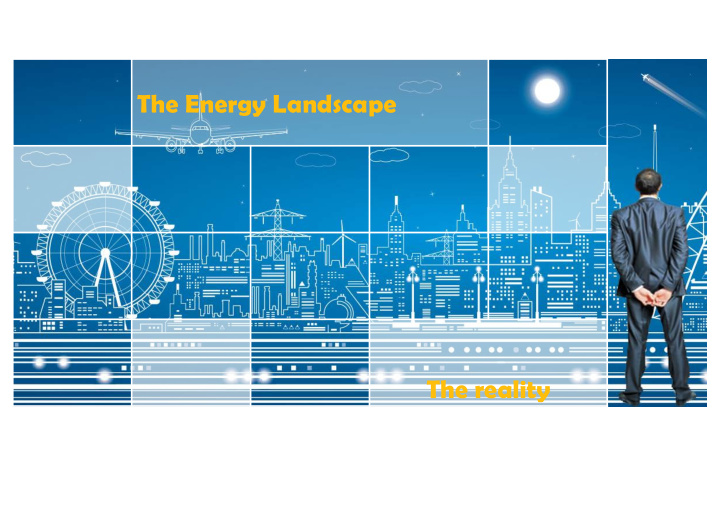



The Energy Landscape The reality
The need for Energy transition Energy consumption and production represents around two-thirds of the global GHG emissions and 81% • of the global energy mix is still based on fossil fuels, the same percentage as 30 years ago. Source: IEA world energy balance 2018 2
The need for Energy transition A transition is needed 9. • The energy transition is a pathway toward transformation of the global energy sector from fossil- • based to zero-carbon by the second half of this century. At its heart is the need to reduce energy- related CO2emissions to limit climate change. Renewable energy and energy efficiency measures can potentially achieve 90% of the required carbon reductions . ( IRENA : https://www.irena.org/energytransition ) 3
The Landscape Energy Source: 100% Renewable Date : tomorrow 4
2050 UAE Energy Mix: What Achieve 50% Clean Energy in Capacity Mix Diverse Energy Mix 44% Renewables Gas-Coal-Nuclear-Solar-Biomass- Wind 6% Nuclear Fossil Clean 40% Demand Side Management 15% Clean Energy in Primary Mix 10% Nuclear 5% Renewables 5
2050 UAE Energy Mix: Why UAE Energy Index 40% Energy Security and Reliability 30% • % of Imported Fuel used in Total Energy Mix • Number of energy sources Energy Affordability 15% 15% • Average Cost of electricity production Happiness • Total investment for capacity Sustainability additions Clean Energy and Emissions • Difference in Cost of Production from • CO2 emissions per GDP 2013 • Share of clean energy in • Total emissions for electricity sector generation mix Energy Efficiency and Productivity • Electricity use per capita • GDP Per Unit of Primary Energy Use 6
The Energy outlook 7
The BP Energy Outlook Carbon emissions Primary energy consumption by fuel Evolving transition (ET) Billion tonnesCO 2 Billion toe Renewables 40 20 2040 Hydro 18 35 Nuclear 16 Coal Gas 30 14 Oil 12 Renewable 25 10 Hydro 8 20 Nuclear 6 Coal 15 4 Evolving transition (ET) 5 Gas Internal combustion engine ban (ICE ban) 2 10 Oil 0 Less gas switching Renewables push (RE push) 5 0 Faster transition (FT) Even faster transition (EFT) 2016 ET ICE Less RE FT EFT 0 ban gas push 1970 1980 1990 2000 2010 2020 2030 2040 switch 8
World Energy Outlook By IEA World Total Primary Energy Demand, Sustainable Development Scenario (SDS) World Total Primary Energy Demand, New Policies Scenario (NPS) 9
Real Challenges …….. 10
Real Challenges …….. Limited resources. • Energy Security and Reliability Storage technologies. • Interconnection limitation • Flexibility • Transport. • 11
Limited Renewable Resources in the region: Solar: Wind: GCC - Global Horizontal Irradiation GCC - Direct Normal Irradiation 12
Impact of the 100% Renewable scenario • Fundamental changes in grid operation and power electronics: The need for balancing services. • The impact on capacity compared to • demand. Need for transmission grid expansion and/or • storage capacity requirements 13
Impact of the 100% Renewable scenario • Regional and global Interconnection: GCC INTERCONNECTION Pan-Arab INTERCONNECTION (Planned) 14
What advances in technology will aid the transition 15
What advances in technology will aid the transition • Electrification of transport sector: 16
What advances in technology will aid the transition • Storage for Upscaling Solar PV But, could energy companies struggle to access the storage they need? 1. Regional demand for battery storage 2. Automotive versus stationary battery storage 3. Second life batteries 17
Industry Energy is used in the industrial sector for a wide range of purposes, such as • process and assembly, steam and cogeneration, process heating and cooling, and lighting, heating, and air conditioning for buildings. Some of these energy uses can be converted to electricity, however, some • remain necessary. This is because industrial sector energy consumption includes basic chemical • feedstock. Natural gas feedstock is used to produce agricultural chemicals. • Natural gas liquids (NGL) and petroleum products (such as naphtha) are both • used for the manufacture of organic chemicals and plastics, among other uses. As per the IEA, since the industry sector is hard to electrify, the focus should be on • energy efficiency to improve the environmental sustainability of the sector. Efforts in optimizing industry processes can have a significant effect on increasing • industry energy productivity and reducing energy demand . 18
What advances in technology will aid the transition • Clean fossil technologies: • Carbon capture , Utilization and sequestration (CCUS) 1. CCS lowers the total societal cost of addressing climate change by approximately 30% 2. CCS will not be widely used until carbon dioxide is regulated. 3. Implementing CCS means a new industry must emerge on a large scale to capture, store and inject carbon dioxide deep underground. It’s not as simple as adding a device to a plant. 4. To improve the business case industrial utilization is required. 19
www.moei.gov.ae 20
Recommend
More recommend